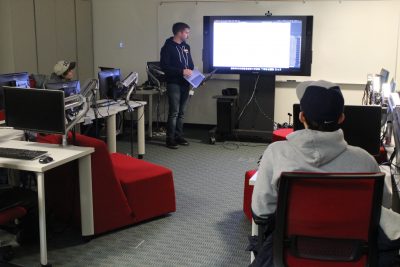 On Friday, February 22nd, OPIM Innovate hosted its Splunk Analytics Workshop. There, Professor Ryan O’Connor, UConn adjunct and Splunk Senior Advisory Engineer, explained to students the origin of Splunk and its uses. Other than Splunk’s three premium solutions: Splunk Information Technology Service Intelligence, Splunk Enterprise Security, and Splunk User Behavior Analytics, attendees also learned of the knowledgeable and supportive community behind the service. From dedicated end-users to passionate Splunk professionals, this community develops intuitive applications utilizing Splunk while also answering each other’s questions. Splunk, therefore, is a user-oriented platform which does everything in its power to help companies and individuals succeed with its data monitoring and visualization software.
On Friday, February 22nd, OPIM Innovate hosted its Splunk Analytics Workshop. There, Professor Ryan O’Connor, UConn adjunct and Splunk Senior Advisory Engineer, explained to students the origin of Splunk and its uses. Other than Splunk’s three premium solutions: Splunk Information Technology Service Intelligence, Splunk Enterprise Security, and Splunk User Behavior Analytics, attendees also learned of the knowledgeable and supportive community behind the service. From dedicated end-users to passionate Splunk professionals, this community develops intuitive applications utilizing Splunk while also answering each other’s questions. Splunk, therefore, is a user-oriented platform which does everything in its power to help companies and individuals succeed with its data monitoring and visualization software.
During the workshop, O’Connor introduced students to time series data, which is how Splunk got its initial patent. In short, time series data is data that has been indexed on a time scale, either to organize the data or to derive conclusions from certain time intervals. For example, credit card companies use time series data in order to deduce whether or not purchases are being made by the authentic cardholder. In Splunk, machine data is categorized and searchable by date and uses time to sort out feasible and non-feasible data. If a purchase is made in one store in Connecticut, and then another store in Vermont 30 minutes later, chances are the card in question has been compromised.
 Splunk is a very flexible service that allows users to integrate data from other software such as SQL Developer, a database client. “Databases are everywhere and important,” O’Connor explained to students, “but, some database clients don’t visualize data well. They just store it, keep its structure, and that’s it.” That is why O’Connor developed an application, called DB Connect, that can grab database information, make a copy of the data inside of Splunk, and then visualize it. “It can make pie charts, line charts, or whatever the case may be,” said O’Connor. “Splunk isn’t designed to replace any one of these [database clients], but instead to aggregate data from them.” Splunk can also capture real-time web data, such as the number of times a server is pinged by a computer or the number of times it is successfully infiltrated.
Splunk is a very flexible service that allows users to integrate data from other software such as SQL Developer, a database client. “Databases are everywhere and important,” O’Connor explained to students, “but, some database clients don’t visualize data well. They just store it, keep its structure, and that’s it.” That is why O’Connor developed an application, called DB Connect, that can grab database information, make a copy of the data inside of Splunk, and then visualize it. “It can make pie charts, line charts, or whatever the case may be,” said O’Connor. “Splunk isn’t designed to replace any one of these [database clients], but instead to aggregate data from them.” Splunk can also capture real-time web data, such as the number of times a server is pinged by a computer or the number of times it is successfully infiltrated.
For those interested in Splunk, Splunk Fundamentals I and II are free for UConn students. The ability to use Splunk Analytics is a very marketable skill, especially for those interested in entering the world of information technology. Also, on March 8th, OPIM Innovate will also be hosting Splunk Day, where students can network with Splunk professionals. Don’t let these important networking opportunities pass you by! Get started with Splunk, today!